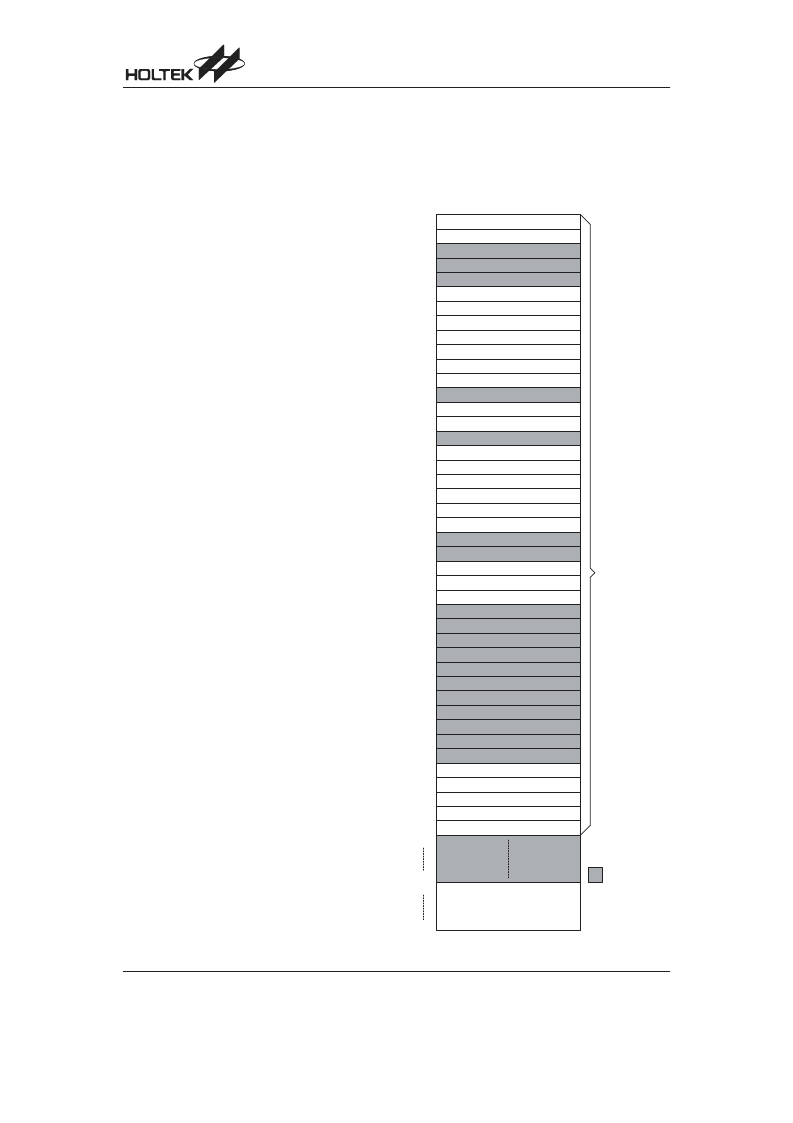- 您現(xiàn)在的位置:買賣IC網(wǎng) > PDF目錄385405 > HT83R074 (Holtek Semiconductor Inc.) Q-Voice PDF資料下載
參數(shù)資料
| 型號(hào): | HT83R074 |
| 廠商: | Holtek Semiconductor Inc. |
| 英文描述: | Q-Voice |
| 中文描述: | 調(diào)Q語(yǔ)音 |
| 文件頁(yè)數(shù): | 10/38頁(yè) |
| 文件大?。?/td> | 252K |
| 代理商: | HT83R074 |
第1頁(yè)第2頁(yè)第3頁(yè)第4頁(yè)第5頁(yè)第6頁(yè)第7頁(yè)第8頁(yè)第9頁(yè)當(dāng)前第10頁(yè)第11頁(yè)第12頁(yè)第13頁(yè)第14頁(yè)第15頁(yè)第16頁(yè)第17頁(yè)第18頁(yè)第19頁(yè)第20頁(yè)第21頁(yè)第22頁(yè)第23頁(yè)第24頁(yè)第25頁(yè)第26頁(yè)第27頁(yè)第28頁(yè)第29頁(yè)第30頁(yè)第31頁(yè)第32頁(yè)第33頁(yè)第34頁(yè)第35頁(yè)第36頁(yè)第37頁(yè)第38頁(yè)

HT83R074
Rev. 1.00
10
May 17, 2007
Data Memory
RAM
The data memory is designed with 80 8 bits. The data
memory is further divided into two functional groups,
namely, special function registers (00H~2AH) and general
purpose user data memory (30H~7FH). Although most of
them can be read or be written to, some are read only.
The general purpose data memory, addressed from
30H~7FH, is used for data and control information un-
der instruction commands.
The areas in the RAM can directly handle the arithmetic,
logic, increment, decrement and rotate operations. Ex-
cept some dedicated bits, each bit in the RAM can be
set and reset by SET [m].i and CLR [m].i . They are
also indirectly accessible through the Memory Pointer
register 0 (MP0:01H).
Indirect Addressing Register
Location 00H is indirect addressing registers that are not
physically implemented. Any read/write operation of
[00H] accesses the RAM pointed to by MP0 (01H) re-
spectively. Reading location 00H indirectly returns the re-
sult00H.While,writingitindirectlyleadstonooperation.
Accumulator
ACC (05H)
The accumulator (ACC) is related to the ALU opera-
tions. It is also mapped to location 05H of the RAM and
is capable of operating with immediate data. The data
movement between two data memory locations must
pass through the ACC.
Arithmetic and Logic Unit
ALU
This circuit performs 8-bit arithmetic and logic opera-
tions and provides the following functions:
Arithmetic operations (ADD, ADC, SUB, SBC, DAA)
Logic operations (AND, OR, XOR, CPL)
Rotation (RL, RR, RLC, RRC)
Increment and Decrement (INC, DEC)
Branch decision (SZ, SNZ, SIZ, SDZ etc)
Status Register
STATUS (0AH)
This 8-bit STATUS register (0AH) consists of a zero flag
(Z), carry flag (C), auxiliary carry flag (AC), overflow flag
(OV), power down flag (PDF), watchdog time-out flag
(TO). It also records the status information and controls
the operation sequence.
Except the TO and PDF flags, bits in the status register
can be altered by instructions similar to other registers.
DatawrittenintothestatusregisterdoesnotaltertheTO
or PDF flags. Operations related to the status register,
however, may yield different results from those in-
tended. The TO and PDF flags can only be changed by
a Watchdog Timer overflow, chip power-up, or clearing
the Watchdog Timer and executing the HALT instruc-
tion. The Z, OV, AC, and C flags reflect the status of the
latest operations.
On entering the interrupt sequence or executing the
subroutine call, the status register will not be automati-
cally pushed onto the stack. If the contents of the status
is important, and if the subroutine is likely to corrupt the
status register, the programmer should take precautions
and save it properly.
3
0 %
3
%
- =
1 =
2 =
5 =
' =
6 =
=
. =
=
=
=
; =
=
=
* =
+ =
- =
1 =
2 =
5 =
' =
6 =
=
. =
=
=
=
; =
=
=
* =
+ =
*
=
*
=
* * =
* + =
* - =
* 1 =
+
=
5 ; =
* 2 =
* 5 =
* ' =
* 6 =
* =
* . =
* ; =
B %
8
% %
%
% C
C
!
. !
. ! =
/
!
=
=
!
=
!
=
!
/
=
!
=
0 %
3
%
%
/
/
!
0
%
0 %
% 7
! 9
.
.
RAM Mapping
相關(guān)PDF資料 |
PDF描述 |
|---|---|
| HT84036 | Magic VoiceTM |
| HT84XXX | Magic VoiceTM |
| HT84072 | Magic VoiceTM |
| HT84144 | Magic VoiceTM |
| HT84192 | Magic VoiceTM |
相關(guān)代理商/技術(shù)參數(shù) |
參數(shù)描述 |
|---|---|
| HT83V31(24SDIP) | 制造商:未知廠家 制造商全稱:未知廠家 功能描述:Analog IC |
| HT83V31(28SDIP) | 制造商:未知廠家 制造商全稱:未知廠家 功能描述:Analog IC |
| HT83V32(24SDIP) | 制造商:未知廠家 制造商全稱:未知廠家 功能描述:Analog IC |
| HT83V32(28SDIP) | 制造商:未知廠家 制造商全稱:未知廠家 功能描述:Analog IC |
| HT83V33(24SDIP) | 制造商:未知廠家 制造商全稱:未知廠家 功能描述:Analog IC |
發(fā)布緊急采購(gòu),3分鐘左右您將得到回復(fù)。